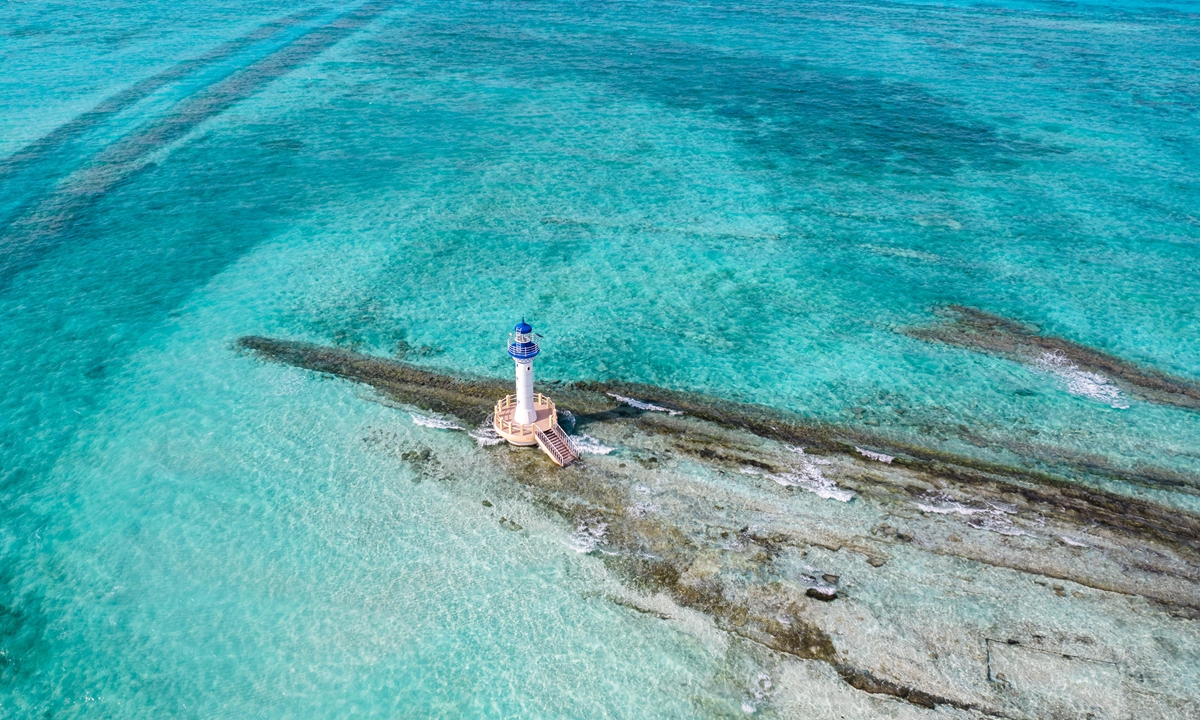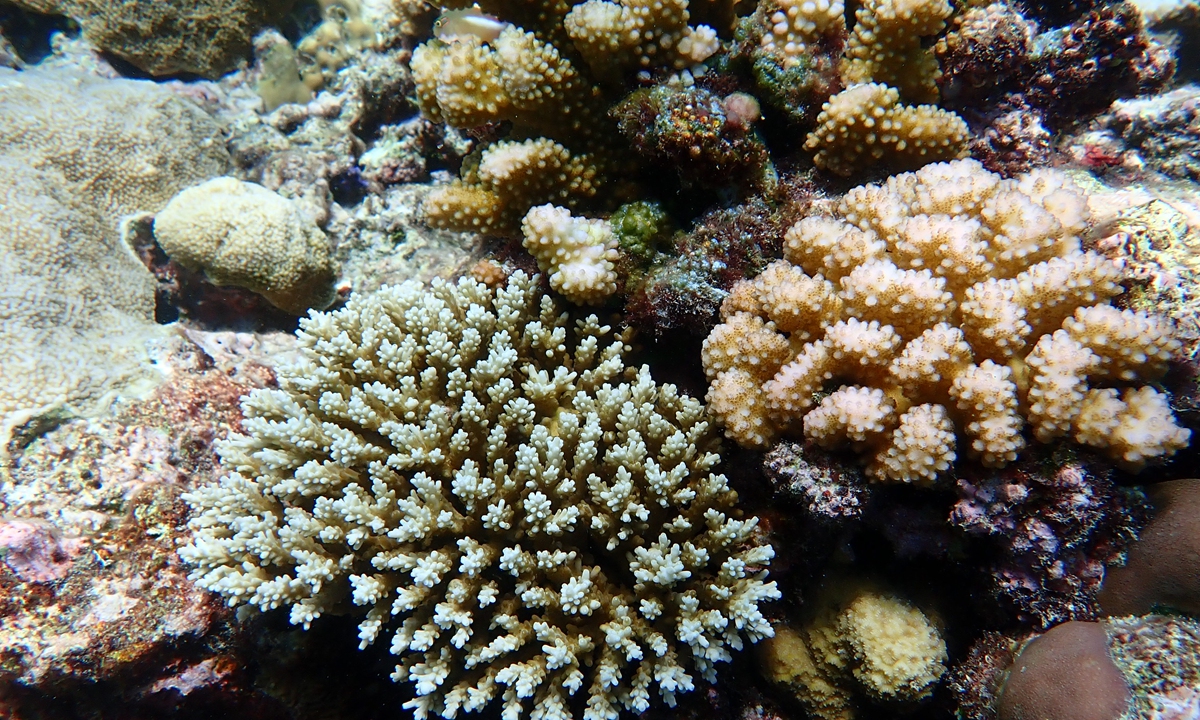Editor's Note:
"Cognitive Warfare" has become a new form of confrontation between states, and a new security threat. With new technological means, it sets agendas and spreads disinformation, to change people's perceptions and thus alter their self-identity. Launching cognitive warfare against China is an important means for Western anti-China forces to attack and discredit the country. Some politicians and media outlets have publicly smeared China's image by propagating false narratives in an attempt to incite and provoke dissatisfaction with China among people in certain countries. These means all serve the US strategy to contain China's rise and maintain its hegemony. The Global Times is publishing a series of articles to reveal the intrigues of the US and its allies' China-targeted cognitive warfare, and expose its lies and vicious intentions. In the 15th installment in the series, under the observation and analysis provided by Chen Xiangmiao, director of the World Navy Research Center at the National Institute for South China Sea Studies, the Global Times has compiled the strategies of cognitive warfare and the "labeling" tactics used by the US and the Philippines. This installment aims to reveal the truth behind the misconceptions and misinterpretations of China's actions in the South China Sea hyped by Western media outlets and think tanks.

An aerial photo of the Xisha Islands Photo: VCG
1. Does China claim the sovereignty of the entire South China Sea?
Misrepresentation: Western countries often exaggerate that China claims the entire South China Sea, accusing China of turning the entire South China Sea into a "Chinese lake."
Fact: Approximately 2 million square kilometers of the sea within the Nine-Dash Line, including the Xisha Islands, Nansha Islands, Dongsha Islands, and Zhongsha Islands, belong to China's territory. The country never claims the entire South China Sea region.
2. When did China start claiming sovereignty in the South China Sea?
Misrepresentation: Some Western narratives suggest that China only began asserting its claims in the South China Sea in 2009.
Fact: These islands in the South China Sea are China's inherent territory. China has a history of over 2,000 years of activities in the South China Sea. China was the first to discover, name, and develop these islands in the South China Sea and has continuously, peacefully, and effectively exercised sovereignty and jurisdiction over them.
China's sovereignty over these islands in the South China Sea and its related rights and interests in the South China Sea were established through a long historical process and have ample historical and legal basis.
3. Did China expand territory in the South China Sea by adding 10th dash line?
Misrepresentation: In August 2023, China's Ministry of Natural Resources released an updated official map delineating the country's geographical territories, which now includes a tenth dash located east of the island of Taiwan. This adjustment from the previous Nine-Dash Line standard is viewed by some Western media as a reflection of China's efforts to assert its influence in the South China Sea region.
Fact: Following the World War II, the Republic of China government, under the leadership of the Kuomintang Party, took control of the Japanese-occupied islands in the South China Sea between October and December 1946. To delineate the territorial boundaries of the South China Sea, the government of the Republic of China has meticulously drawn, surveyed, and published the "Map of the South China Sea Islands." This map clearly identifies the Dongsha Islands, Xisha Islands, Zhongsha Islands, and Nansha Islands in a north to south direction, encompassing the area from the land boundary between China and Vietnam in the Beibu Gulf to the eastern part of island of Taiwan. It is important to note that the dashed line in the eastern part of Taiwan has long been established and is unrelated to the Nine-Dash Line in the current South China Sea. The island of Taiwan has always been an integral part of China's territory historically.
4. Is China 'militarizing' the South China Sea?
Misrepresentation: Some Western narratives have exaggerated China's activities in the South China Sea, portraying them as "aggressive land reclamation and militarization."
Fact: China's development on its own islands and reefs is focused on improving infrastructure, resource utilization, and defense capabilities. On the contrary, it is the US that is significantly increasing its military presence in the region, with reports showing heightened deployment of aircraft carriers, submarines, and bombers, as well as close-in reconnaissance operations and joint exercises.

Coral reefs growing on the outer reef slope of Huangyan Island Photo: Courtesy of South China Institute of Environmental Sciences under China Ministry of Ecology and Environment
5. Is China the 'destroyer' of the South China Sea ecosystem?
Misrepresentation: Some media, such as the New York Times, are concerned that China's growing fish consumption and fishing activities are posing a threat to world maritime resources. Meanwhile, the Philippines government has long accused China of illegal fishing that damages the South China Sea ecosystem.
Fact: In recent years, in order to promote the scientific conservation and long-term sustainable use of global fishery resources, China has not only strictly implemented fishing moratorium policies in its territorial waters, but has also cracked down on illegal fishing, setting a model for global marine ecological preservation through innovative measures.
China recently released the
first investigative and assessment report on the ecological environment near Huangyan Dao (also known as Huangyan Island) in the South China Sea, revealing that the area enjoys excellent eco-environmental quality.
6. Is China impeding 'freedom of navigation' in the South China Sea?
Misrepresentation: The US and some Western countries have accused China of taking actions against the US' close-in reconnaissance operations and law enforcement activities, which they claim threaten freedom of navigation.
Fact: China's measures to respond to US military activities are not aimed at restricting freedom of navigation. The US' interpretation of freedom of navigation seems to imply that China should ignore its military actions, which would actually violate the sovereignty of other countries. China upholds freedom of navigation in accordance with the rules of the United Nations Convention on the Law of the Sea, ensuring navigation rights in the South China Sea. Even when foreign warships pass through the area, as long as they comply with the convention, China remains open and does not obstruct them.
The Chinese Ministry of Foreign Affairs has affirmed that there are no issues with the freedom of navigation in the South China Sea. Countries outside the region, led by the US, are continually forming alliances in the South China Sea, using cooperation as a facade for confrontation, peace as a cover for flexing their military muscles, and order as a pretext for creating disorder, all of which demonstrate clear hegemonic behavior.
7. Is China a 'breaker of international rules?'
Misrepresentation: Biased narratives by the Philippine government and some of its political allies have claimed that China does not abide by the 2016 South China Sea arbitration ruling, thereby violating international rules. These narratives have also alleged that China is using the negotiations for the "
Code of Conduct in the South China Sea" to pressure neighboring countries into accepting regional rules against their will.
Fact: China has consistently maintained its stance of "non-acceptance, non-participation, and non-recognition" of the arbitration ruling, rejecting any claims or actions based on it. It is important to note that UNCLOS does not govern matters of territorial sovereignty. The Arbitral Tribunal disregarded China's position and opinions expressed through official channels, and instead accepted the Philippines' claims in a manner that circumvented legal obstacles to initiate the arbitration process.
The ruling on sovereignty over islands and reefs went against the usual principles of prudence and self-discipline followed by international judicial and arbitral institutions.
Both the "Declaration on the Conduct of Parties in the South China Sea" and the ongoing negotiations for the "
Code of Conduct in the South China Sea" are founded on principles of equality, mutual respect, and consideration for each other's concerns.
8. Is China seeking 'regional hegemony?'
Misrepresentation: Some sources such as US Department of Defense stated that China is seeking hegemony in the South China Sea through militarization, which is used as a justification for US military presence and confrontation in the region.
Fact: China has always advocated for partnership without alliance, engaging in dialogue and consultation with neighboring countries on the basis of equality and fairness, without imposing its will on others or attempting to establish a regional hegemony. The Chinese do not hold the same hegemonic mindset as the Americans.
9. Is China using 'gray zone' tactics in the South China Sea?
Misrepresentation: Some media reports such as by the New York Times and South China Morning Post stated that the Chinese fishermen in the South China Sea are military forces supported, commanded, trained, and mobilized by the People's Liberation Army.
Fact: These are ordinary fishermen who play a crucial role in safeguarding national security interests in accordance with internationally accepted management rules. Similar arrangements can be found in neighboring countries and the US. Fishermen, along with the Chinese coast guard, are important forces in maintaining security and peace in the South China Sea, with the goal of preventing conflicts from escalating.
When facing national security threats, according to Chinese domestic laws and international practices, fishermen have the obligation and responsibility to participate in defending national security.
10. Did China obstruct the undersea cables laid in the South China Sea?
Misrepresentation: According to reports from the Financial Times of the UK and the Nikkei Asian, China is impeding the installation and upkeep of undersea cables in the South China Sea by imposing extensive approval procedures and stringent regulations. This has compelled cable companies to devise alternative routes that bypass the South China Sea.
Fact: It is important to clarify that China has been actively promoting the construction of global information infrastructure, including submarine cables, and has complied with international laws and regulations. The Chinese government has always welcomed and supported other countries and telecommunications companies laying international submarine cables in Chinese jurisdictional waters.







